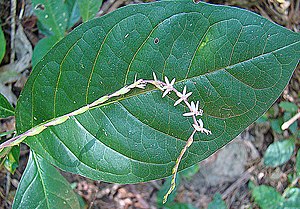Note: This is a project under development. The articles on this wiki are just being initiated and broadly incomplete. You can Help creating new pages.
Petiveria alliacea - Guinea henweed
Petiveria is a genus of flowering plants in the pigeonberry family Petiveriaceae. It is native to United States, Mexico, Central America, the Caribbean and tropical South America. It is a deeply rooted herbaceous perennial shrub growing up to 1 m tall. The roots and leaves have a strong acrid, garlic-like odor which taints the milk and meat of animals that graze on it.
Contents
- 1 Uses
- 2 Parts Used
- 3 Chemical Composition
- 4 Common names
- 5 Properties
- 6 Habit
- 7 Identification
- 8 List of Ayurvedic medicine in which the herb is used
- 9 Where to get the saplings
- 10 Mode of Propagation
- 11 How to plant/cultivate
- 12 Commonly seen growing in areas
- 13 Photo Gallery
- 14 References
- 15 External Links
Uses
Diarrhoea, Stimulate the uterus, Nervous spasms, Paralysis, Hysteria, Asthma, Whooping cough, Pneumonia, Bronchitis, Hoarseness, Fevers.[1]
Parts Used
Chemical Composition
Many biologically active compounds have been isolated from all parts of the plant, the most important ones being sulphur compounds, but flavonoids, triterpenes and steroids have also been identified.[2]
Common names
| Language | Common name |
|---|---|
| Kannada | |
| Hindi | |
| Malayalam | |
| Tamil | |
| Telugu | |
| Marathi | |
| Gujarathi | |
| Punjabi | |
| Kashmiri | |
| Sanskrit | |
| English | Guinea Henweed, Anamu, Garlic weed |
Properties
Reference: Dravya - Substance, Rasa - Taste, Guna - Qualities, Veerya - Potency, Vipaka - Post-digesion effect, Karma - Pharmacological activity, Prabhava - Therepeutics.
Dravya
Rasa
Guna
Veerya
Vipaka
Karma
Prabhava
Habit
Identification
Leaf
| Kind | Shape | Feature |
|---|---|---|
Flower
| Type | Size | Color and composition | Stamen | More information |
|---|---|---|---|---|
| {{{5}}} |
Fruit
| Type | Size | Mass | Appearance | Seeds | More information |
|---|---|---|---|---|---|
Other features
List of Ayurvedic medicine in which the herb is used
Where to get the saplings
Mode of Propagation
Seeds, Cuttings of half-ripe wood.
How to plant/cultivate
Prefers a rich, moist soil and a position in partial shade.[4]
Commonly seen growing in areas
Semi-shaded roadsides, Well-drained area, Undisturbed ground.
Photo Gallery
References
- ↑ Indian Medicinal Plants by C.P.Khare
- ↑ Chemical constituents
- ↑ [Morphology]
- ↑ Cultivation
External Links
- Ayurvedic Herbs known to be helpful to treat Diarrhoea
- Ayurvedic Herbs known to be helpful to treat Stimulate the uterus
- Ayurvedic Herbs known to be helpful to treat Nervous spasms
- Ayurvedic Herbs known to be helpful to treat Paralysis
- Ayurvedic Herbs known to be helpful to treat Hysteria
- Ayurvedic Herbs known to be helpful to treat Asthma
- Ayurvedic Herbs known to be helpful to treat Whooping cough
- Ayurvedic Herbs known to be helpful to treat Pneumonia
- Ayurvedic Herbs known to be helpful to treat Bronchitis
- Ayurvedic Herbs known to be helpful to treat Hoarseness
- Ayurvedic Herbs known to be helpful to treat Fevers
- Herbs with Roots used in medicine
- Herbs with Leaves used in medicine
- Herbs with common name in English
- Habit - Perennial
- Index of Plants which can be propagated by Seeds
- Index of Plants which can be propagated by Cuttings of half-ripe wood
- Herbs that are commonly seen in the region of Semi-shaded roadsides
- Herbs that are commonly seen in the region of Well-drained area
- Herbs that are commonly seen in the region of Undisturbed ground
- Herbs
- Pages without herbs images





